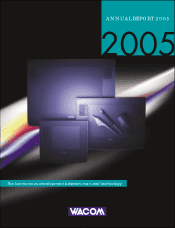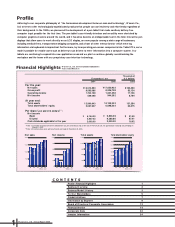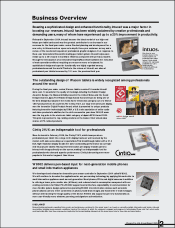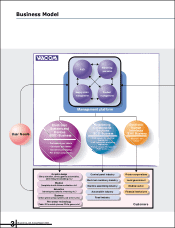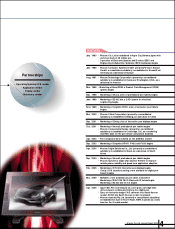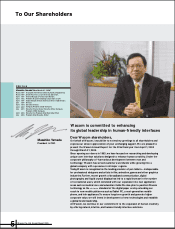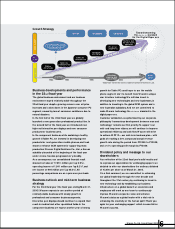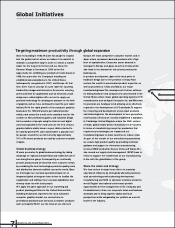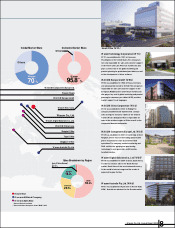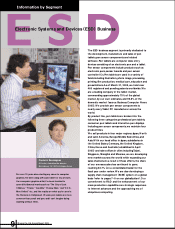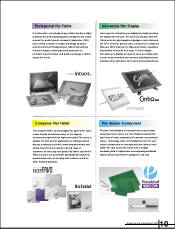Wacom 2005 Annual Report Download - page 8
Download and view the complete annual report
Please find page 8 of the 2005 Wacom annual report below. You can navigate through the pages in the report by either clicking on the pages listed below, or by using the keyword search tool below to find specific information within the annual report.
W acom Co., Ltd. Annual Report 2005
7
Since its founding in 1983, W acom has sought to expand
into the global market, where we believe it is essential to
maintain a competitive edge in order to remain a market
leader for the long term. To that end, we chose the
Hanover Messe in Germany in 1984 as the first
opportunity for exhibiting our products in trade shows. In
1988, five years after the Company’s founding, we
established sales subsidiaries in the United States
(subsequently reorganized in 1991) and Europe. At that
time, there was no concept of a pen tablet for inputting
handwritten images and characters. D evices for entering
points and lines for applications such as electronic circuit
design were called digitizers. W e set out to apply our
patented technology for sensing pen pressure to the field
of graphics, and we have continued to lead the pen tablet
industry. W ith the rapid growth of the computer graphics
business in the 1990s, W acom’s pen tablets became
widely used across the world as the standard tool for the
creation of films, animations, games, and industrial design.
As the number of people using the Internet and digital
cameras expanded in the early years of the 21st century,
graphics tablets, widely known as pen tablets, started to
be used by general PC users and became a popular tool
for people around the world. Currently approximately
70% of W acom’s products are used by customers outside
of Japan.
Global business strategy
W acom promotes its global business strategy by taking
advantage of regional characteristics and makes full use of
our strengths as a group. Consequently, we continually
provide products and services that meet customer needs
by combining the best technologies, products, quality, costs,
and distribution channels available across the world. Since
we first began our overseas operations based on an
integrated global strategy, we have striven to localize the
organization and staffing of our overseas subsidiaries and
develop close ties with local people.
W e apply this same approach in our marketing and
product planning activities. In the United States which,
including H ollywood, represents the most advanced
computer graphics market, we concentrate on
professional products such as Intuos. Consumer products
such as Graphire/FAVO are the focus of our efforts in
Europe, the most competitive consumer market, and in
Japan, where consumers demand products with a high
level of sophistication. Corporate sector demand is
strongest in Europe and Japan, as well as in Asia, which
also leads in the demand for low-priced products for
business use.
In product development, Japan is the focal point of
hardware design due to the presence of many R&D
centers, the wealth in accumulated product expertise, as
well as proximity to China and Taiwan, our major
manufacturing bases. The development of driver software
for linking hardware and computers is concentrated in the
United States, where major global operating systems (O S)
manufacturers such as Apple Computer, Inc. and Microsoft
Corporation are headquartered, allowing us to effectively
respond to the development of O S standards. To support
the marketing and development of pen-input products
and technologies for the development of next-generation,
multi-function devices, we recently established a subsidiary
in Cambridge, United Kingdom, where the R&D centers
of major global mobile phone manufacturers are located.
In terms of manufacturing, except for production that
requires key technologies, we transferred our
manufacturing bases to Asian countries to reduce costs.
As part of the transfer of our manufacturing operations,
we ensure high product quality by providing technical
guidance and support to electronics manufacturing
services (EMS) production lines in China and Taiwan. W e
also moved our supply chain management (SCM) base to
China to support the transference of our manufacturing,
in line with the globalization of the group.
Share the vision and strategy
W e have striven through these efforts to maximize
operational efficiency by strategically allocating functions
such as marketing, product planning, development,
manufacturing, and SCM to optimum locations across the
world. Regular international conferences provide
opportunities for the management of the Company and
its subsidiaries to share our corporate vision and business
strategies and to bring together global and local
perspectives while safeguarding our position as a world
leader in the industry.
Targeting maximum productivity through global expansion

